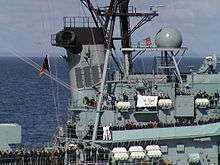German destroyer Lütjens
 | |
| History | |
|---|---|
| Name: | Lütjens |
| Namesake: | Admiral Günther Lütjens |
| Builder: | Bath Iron Works |
| Yard number: | DDG-28 |
| Laid down: | 1 March 1966 |
| Launched: | 11 August 1967 |
| Commissioned: | 22 March 1969 |
| Decommissioned: | 18 December 2003 |
| Homeport: | Kiel |
| Identification: | D185 |
| Fate: | to be sold for scrapping[1] |
| General characteristics | |
| Class and type: | Lütjens-class destroyer |
| Displacement: | 4720 t |
| Length: | 133.2 m (437 ft) |
| Beam: | 14.3 m (47 ft) |
| Draft: | 6.1 m (20 ft) |
| Propulsion: |
|
| Speed: | 33 knots (61 km/h; 38 mph) |
| Range: | 4,500 nautical miles (8,300 km) at 20 knots (37 km/h; 23 mph) |
| Complement: | 337 |
| Sensors and processing systems: |
|
| Electronic warfare & decoys: |
|
| Armament: |
|
The German destroyer Lütjens was the lead ship of the her class, a modified version of the American Charles F. Adams class, built for the Bundesmarine (West German Navy) during the 1960s.
Design and description
The Charles F. Adams class was based on a stretched Forrest Sherman-class destroyer hull modified to accommodate an RUR-5 ASROC Launcher and all their associated equipment. The ships had an overall length of 134.4 meters (440 ft 11 in), a beam of 14.4 meters (47 ft 3 in) and a deep draft of 4.5 meters (14 ft 9 in). They displaced 4,526 metric tons (4,455 long tons) at full load. Their crew consisted of 333 officers and enlisted men.[2]
The ships were equipped with two geared General Electric steam turbines, each driving one propeller shaft, using steam provided by four D-V2M water-tube boilers. The turbines were intended to produce 70,000 shaft horsepower (52,000 kW) to reach the designed speed of 36 knots (67 km/h; 41 mph). The Lütjens class had a range of 4,500 nautical miles (8,300 km; 5,200 mi) at a speed of 20 knots (37 km/h; 23 mph). Unlike their half-sisters, the ships had two macks.[2]
They were armed with two 5"/54 caliber Mark 42 gun forward, one each forward and aft of the superstructure. The ships were fitted with an eight-round ASROC launcher between the funnels. Close-range anti-submarine defense was provided by two triple sets of 324-millimetre (12.75 in) Mk 32 torpedo tubes. The primary armament of the ships was the Tartar surface-to-air missile designed to defend the carrier battle group. They were fired via the single-arm Mk 13 missile launcher and the ships stowed a total of 40 missiles for the launcher.[2]
Construction and career
The ship was named for Admiral Günther Lütjens, who commanded a battlegroup comprising the German battleship Bismarck and the cruiser Prinz Eugen during Operation Rheinübung (Exercise Rhine). Lütjens was killed when Bismarck was surrounded by overwhelming British naval force on 27 May 1941 in the North Atlantic. She was laid down at Bath Iron Works in Bath, Maine on 1 March 1966 with the hull classification symbol DDG-28. She was launched on 11 August 1967 and commissioned on 22 March 1969. On 14 September 2001, three days after the terrorist attacks on 11 September, the crew of Lütjens manned the rails, and as they approached the destroyers USS Winston S. Churchill and USS Gonzalez, they displayed an American flag and a banner reading "We Stand By You."
After over 30 years of service and a travelled distance of 800,000 nautical miles (1,500,000 km) Lütjens was decommissioned on 18 December 2003. She was the last steam-powered vessel and the last ship classified as a destroyer of the German Navy.

Notes
- ↑ http://www.vebeg.de/images/lospics/29/14229.001.pdf Zerstörer ex "LÜTJENS" Klasse 103 B (teildemilitarisiert)
- 1 2 3 Gardiner, Chumley & Budzbon, p. 143
References
- Friedman, Norman (1982). U.S. Destroyers: An Illustrated Design History. Annapolis, Maryland: Naval Institute Press. ISBN 0-87021-733-X.
- Gardiner, Robert; Chumbley, Stephen & Budzbon, Przemysław (1995). Conway's All the World's Fighting Ships 1947-1995. Annapolis, Maryland: Naval Institute Press. ISBN 1-55750-132-7.
External links
| Wikimedia Commons has media related to D185 Lütjens (ship, 1969). |